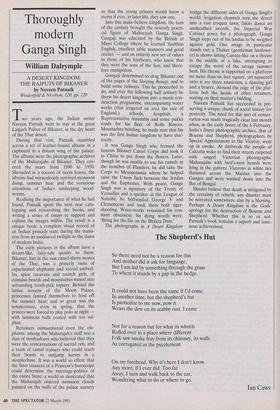Thoroughly modern Ganga Singh
William Dalrymple
A DESERT KINGDOM: THE RAJPUTS OF BIKANER by Naveen Patnaik Weidenfeld & Nicolson, £20, pp. 120 Two years ago, the Indian writer Naveen Patnaik went to stay at the great Lalgarh Palace of Bikaner, in the dry heart of the Thar desert.
During that visit, Patnaik stumbled across a set of leather-bound albums in a cupboard in a distant wing of the palace. The albums were the photographic archives of the Maharajahs of Bikaner. They cov- ered the years from 1890 to 1950. Shrouded in a cocoon of neem leaves, the albums had miraculously survived monsoon damp, summer heat and the voracious attentions of India's unsleeping wood- worms.
Realising the importance of what he had found, Patnaik spent the next year cata- loguing and researching the books, and writing a series of essays to support and explain the images within. The result is a unique book: a complete visual record of an Indian princely state during the transi- tion from its mediaeval twilight to the dawn of modern India.
The early pictures in the album have a dream-like, fairy-tale quality to them: Bikaner, lost in the vast camel-thorn wastes of the Thar, was a princely oasis of caparisoned elephants and sacred umbrel- las, spice caravans and nautch girls, of cumulus beards and moustaches waxed into astounding tooth-pick topiary. Behind the lattice screens of the Moon Palace, princesses fanned themselves to fend off the summer heat; and so great was the temperature, even in spring, that the princes were forced to play polo at night — with luminous balls coated with sea sul- phur.
Retainers outnumbered even the ele- phants: among the Maharajah's staff was a clan of troubadours who believed that they were the reincarnations of sacred rats, and a team of camel trainers who could teach their beasts to outjump horses in a steeplechase. It was a world so effete that the finer nuances of a Princess's horoscope could determine the marriage-politics of the entire State; a world so desiccated that the Maharajah ordered monsoon clouds painted on the walls of the palace nursery so that the young princes would know a storm if ever, in later life, they saw one.
Into this make-believe kingdom, the turn of the century brought the severely practi- cal figure of Maharajah Ganga Singh. Gangaji was educated by the British at Mayo College where he learned 'faultless English, excellent table manners and good cricket' — and an entirely new set of values to those of his forebears, who knew that they were the sons of the Sun, and there- fore omnipotent.
Gangaji determined to drag Bikaner out of the pages of the Sleeping Beauty, and to build some railways. This he proceeded to do, and over the following half century he threw his desert kingdom into a manic con- struction programme, encompassing water works (that irrigated an area the size of
England,) schools, hospitals, a Representative Assembly and some pukka roads for his fleet of Rolls Royces. Moustaches bristling, he made sure that his was the first Indian kingdom to have elec- tricity.
It was Ganga Singh who formed the famous Bikaner Camel Corps alid took it to China to put down the Boxers. Later, though he was unable to use his camels in the trenches of Flanders, he did take the Corps to Mesopotamia where he helped raise the Union Jack between the Jordan and the Euphrates. With peace, Ganga Singh was a signatory of the Treaty of Versailles and a speaker at the League of Nations; he befriended George V and Clemengeau and took them both tiger- shooting. Water-works remained his con- stant obsession; his dying words were: 'Bring me the file on the Bhalcra Dam.'
The photographs in A Desert Kingdom bridge the different sides of Ganga Singh's world: irrigation channels turn the desert into a vast croquet lawn, fakirs dance on unsheathed swords; the Imperial War Cabinet poses for a photograph, Ganga Singh steps out of his landau to be weighed against gold. One image in particular stands out: a Thakur (gentleman landown- er) is shown sitting Canute-like on a throne in the middle of a lake, attempting to escape the worst of the savage summer heat. His throne is supported on a platform no more than six feet square, yet squeezed onto it are three musicians, a dancing girl and a bearer. Around the edge of the plat- form bob the heads of other retainers, waiting on their master's bidding.
Naveen Patnaik has succeeded in pre- serving a unique chunk of social history for posterity. The need for this sort of conser- vation was made tragically clear last month when, in the early hours of the 6 February, India's finest photographic archive, that of Bourne and Shepherd, photographers by Special Appointment to the Viceroy, went up in smoke. At daybreak the people of Calcutta woke to find their streets carpeted with singed Victorian photographs: Maharajahs with bird's-nest beards were lying in the gutters; Viceroys in white ties fluttered across the Maidan into the Ganges and were washed down into the Bay of Bengal.
Hindus believe that death is mitigated by the certainty of rebirth; any disaster must be mirrored somewhere else by a blessing. Perhaps A Desert Kingdom is the Gods' apology for the destruction of Bourne and Shepherd. Whether this is so or , not, Patnaik's book remains a superb and lumi- nous achievement.


























































 Previous page
Previous page